April 2019 Newsletter
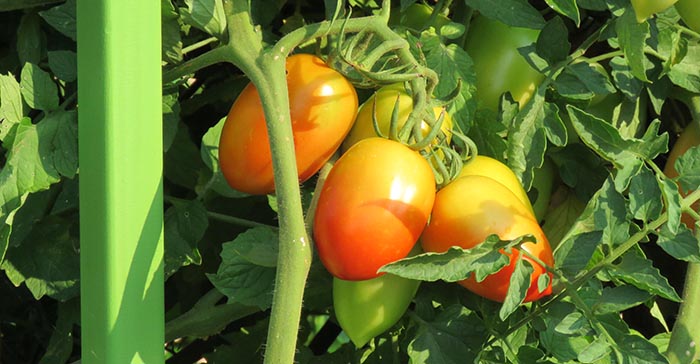
Photo by Sue Lannon
Vegetable Gardening Goodness
“It’s difficult to think anything but pleasant thoughts while eating a homegrown tomato.”
- Lewis Grizzard
Picture a warm summer’s evening, sitting down to a meal of vegetables from your own garden—the intensity of the flavors that awaken the senses, the feeling of wellbeing as you feed your body with nutritious goodness, the appreciation you feel for nature’s ingenuity.
Is your mouth watering yet?
While it may seem premature to think of summer evenings in April, it’s actually the ideal time to consider growing your own fruits and vegetables at home so homegrown goodness can be an integral part of your summer evenings.
We sat down with Lindsey Luks, horticulturist in the Doris Duke Center Gardens, to discuss tips for growing fruits and vegetables in gardens of all sizes for gardeners of all abilities. If anyone knows about vegetable gardening, it’s Lindsey. She grew up on a farm in eastern North Carolina and from an early age helped her father and grandfather plant their crops. Lindsey went on to study horticulture at N.C. State University and joined the Duke Gardens team in 2011, in part to help grow our then newly established Charlotte Brody Discovery Garden. Since the garden’s dedication in 2012, more than 7.4 tons of produce have been harvested in the Discovery Garden and donated to Healthy Families Durham, a local nonprofit that provides healthy food and nutritional guidance to families in need. To say that Lindsey and her team have had a successful yield is an understatement.
With the following information in our gardening arsenal, Lindsey reassures us that we can also enjoy vegetable gardening success at home. It is as easy as it is rewarding, with plants that are forgiving even to those of us whose thumbs are far from green.
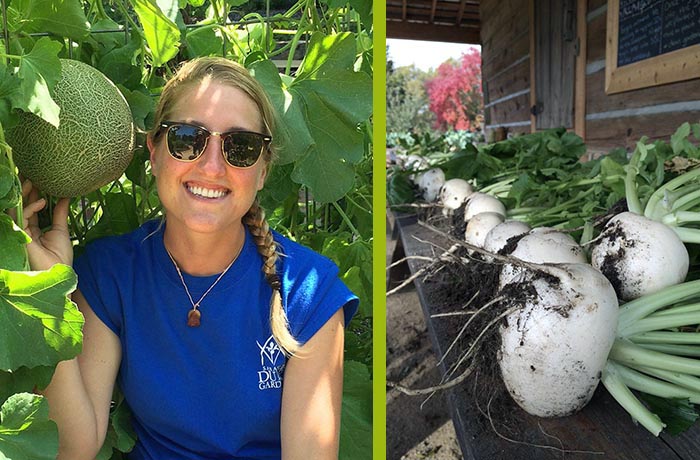
Lindsey Luks in the Charlotte Brody Discovery Garden. Turnips harvested at Duke Gardens.
Getting Started
April is a great time to create a vegetable garden at your home. The general rule of thumb is to start planting fruit and vegetable varieties after the last spring frost of the year, which is around April 15 for those living in the Triangle area. If you live in other parts of the country, you can find out more about the last spring frost by visiting websites like The Old Farmer’s Almanac or by consulting your local Cooperative Extension agent.
The first step is to prepare the soil in your beds. It’s worth investing time in your soil from the outset, because healthy soil makes a healthy plant. Start with a soil test so you’ll know what nutrients may be lacking or overly abundant. You may want to consider using raised garden beds, which allow you to control the type of soil and nutrients you use. You can also use containers with good drainage if raised beds are not an option. A lot of supply stores now sell container varieties of your favorite fruit and vegetable plants, which are essentially dwarf cultivars. But don’t let their size fool you; container varieties often produce just as much as their larger relatives. Last year, Duke Gardens planted a container variety of eggplant called ‘Patio Baby,’ which produced numerous standard-sized eggplants throughout the summer.
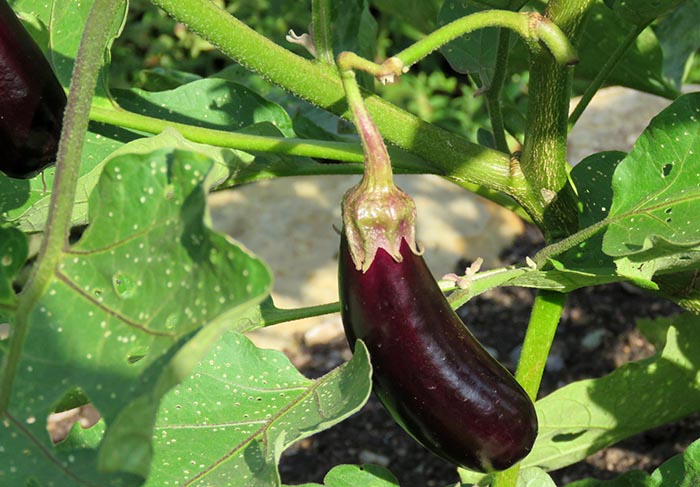
'Patio Baby' eggplant. Photo by Sue Lannon.
Select a soil medium that promotes good drainage, such as sandy loam soil, then mix soil amendments down into the soil to improve its nutrients and encourage microorganism growth. Amendments, which modify the condition of the soil itself, will set you up for success and make growing simpler. We use the following soil amendments in the Charlotte Brody Discovery Garden:
- feather meal (a source of nitrogen)
- Tennessee brown rock (a source of phosphorus)
- bone meal ( a source of phosphorus)
- greensand (a source of potassium)
- dolomitic lime (a source of calcium)
- fresh compost
We can’t emphasize it enough: healthy soil makes healthy plants, so start yours off right.
Planting Companions
Once the last spring frost has passed and you have prepared your soil, your plants are ready to go in the ground. Fruit, vegetable and herb varieties need at least 6 or more hours of direct sunlight, so make sure you position your plants in sunny areas of your garden.
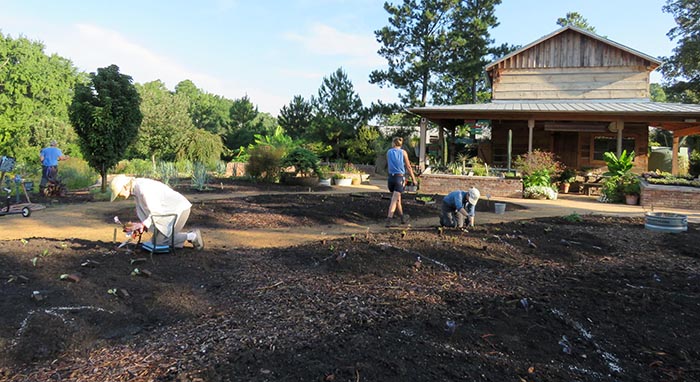
Horticulturists and volunteers planting in the Charlotte Brody Discovery Garden. Photo by Sue Lannon.
You may also want to consider the practice of companion planting as you start to lay out where your plants will go. Companion planting is based on the idea that certain plants grow better together. Tomatoes, for instance, are often grown with basil because it is believed that basil enhances the tomato’s flavor (Caprese salad, anyone?). While we’re not sure if this flavor enhancement could be proven scientifically, companion planting does have many additional benefits: it can deter insects, attract pollinators, lower erosion and reduce the number of weeds to produce larger yields. It also eliminates a monoculture of plants, which can lead to disease and insect infestations.
One of the most common and historic companion planting groups is known as the “Three Sisters”: corn, beans and squash. Originally planted together by Native Americans, this trio thrives when inter-planted. Corn stalks offer beans the support they need to grow high toward the sun. Beans pull nitrogen from the air to enrich the soil. The large leaves of the squash plant protect the corn and beans by shading the soil, keeping it cool, moist, and weed free. Their prickly surface also deters animals from snacking on the plants.
Other examples include planting marigolds in your vegetable beds to attract beneficial insects and repel harmful insects, and planting onions with brassicas like broccoli, cauliflower and cabbages.
While it may take some time to identify plant companions and incorporate them into your garden design, in the long run the effort pays off in spades.
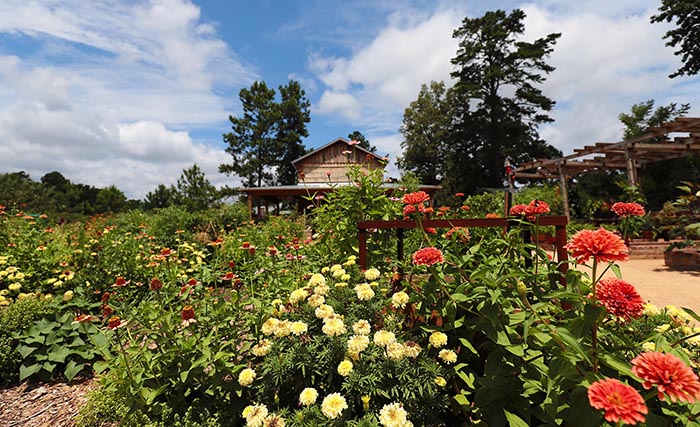
The Charlotte Brody Discovery Garden in summer. Photo by Brian Wells.
To Seed or Not to Seed
All of the fruits and vegetables in the Charlotte Brody Discovery Garden are planted from seed in order to produce a larger variety of cultivars. As part of our mission of education, we strive to show visitors some varieties that are not widely available in supermarkets and supply stores.
Planting from seed has a few advantages. In addition to enabling us to grow these harder-to-find varieties, seeds rely on sexual reproduction, which in turn creates more genetic diversity and plants that are more vigorous and disease resistant than asexually produced plants (cultivars). Seeds are also more economical; a seed packet often costs the same as a single plant, but each packet produces multiple plants. It’s also an easy and rewarding process (learn more about seed propagation here).
If you want to start your plants from seed and then transplant them into your garden, it’s best to start in the winter. Onion seeds can be sown in January; tomatoes, eggplant and peppers in February; and squash and melons in March, since they grow quickly. Some plants—such as sunflowers, corn, peas and many root vegetables—prefer to be seeded directly in the ground. You can check with your local Cooperative Extension office and Master Gardeners to learn more.
In fact, Durham County Extension Master Gardeners are available to answer your gardening questions in person on Tuesdays and Saturdays from 10 a.m. to 1 p.m. in the Charlotte Brody Discovery Garden.
When it’s time to plant your seed starters in the ground, or if you are ready to plant your store-bought plants, make sure you give them space to grow. Lettuce heads, tomatoes and corn typically need around 12 inches of space on all sides; peppers, potatoes and cabbages need around 15 to 18 inches.
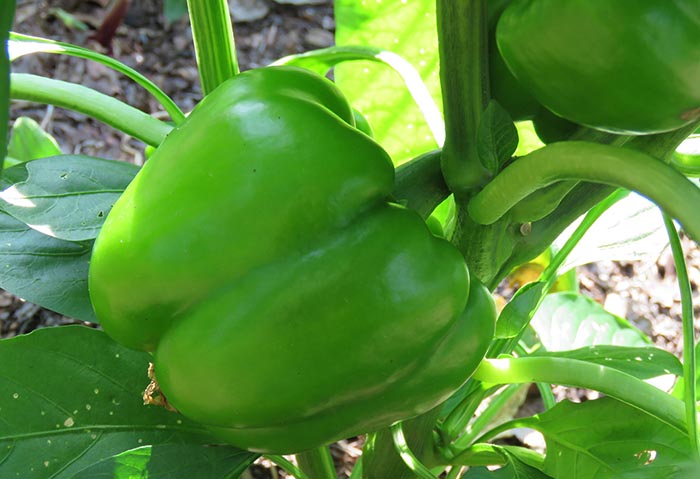
Green peppers. Photo by Sue Lannon.
Reaping What You Sow
With your plants now in the soil, you can focus on nurturing them with regular water, nutrients and TLC. Vegetable gardens tend to need more water than established perennial gardens, so the general rule of thumb is to make sure they get a good watering at least twice a week during the summer. If it rains one time during a particularly hot week, for instance, water the plants one more time that week. Vegetable varieties can also be heavy feeders, so regular fertilization is important. If your soil has been enriched with soil amendments from the outset, it is advisable to fertilize your garden two more times, at 4 weeks after the initial planting and again at 8 weeks after planting. You can use a pre-mixed fertilizer like organic garden-tone, lightly scattered over the top of the soil.
If all goes well, you should be able to start harvesting fruits and vegetables like tomatoes, peppers and okra in mid-June, and keep harvesting crops until the first frost of the fall. In fact, the more you harvest, the more your plants will produce, so keep taking care of them.
You will be rewarded with a full season of health, with food high in nutrients and low in pesticides. You’ll save money and increase your physical activity. And you’ll get to indulge in homegrown yumminess all summer long.
Thank you, Lindsey!
Duke Gardens offers many informative and fun programs for adults, children and families throughout the year. To learn more about vegetable gardening and the Charlotte Brody Discovery Garden this spring, check out the following family programs in April and May:
Discovery Drop-In in the Charlotte Brody Discovery Garden
Tuesday, April 23
3 to 5 p.m.
Meet the Gardens’ Keepers
Thursdays, May 2, 9 and 16
2 to 3 p.m.
Family Garden Walk
Saturday, May 4
9 to 9:45 a.m.
These are all drop-in events. Advance registration is not required. Visit gardens.duke.edu/events to learn more.





